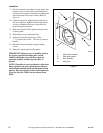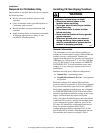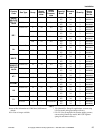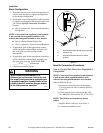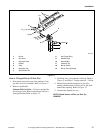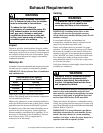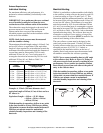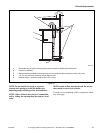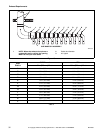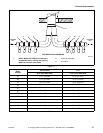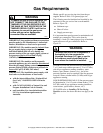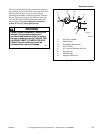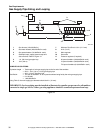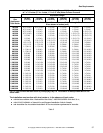
Exhaust Requirements
M414905
30
© Copyright, Alliance Laundry Systems LLC – DO NOT COPY or TRANSMIT
Individual Venting
For maximum efficiency and performance, it is
preferred to exhaust tumbler(s) individually to the
outdoors.
IMPORTANT: At no point may the cross sectional
area of installed venting be less than the cross
sectional area of the exhaust outlet of the tumbler.
The exhaust duct must be designed so the static back
pressure measured 12 inches (305 mm) from the
exhaust outlet does not exceed the maximum
allowable pressure specified on the installation sticker
on the rear of the tumbler.
NOTE: Static back pressure must be measured
with the tumbler running.
The maximum allowable length venting is 14 feet (4.3 m)
and two 90° elbows or equivalent. If the equivalent
length of a duct required for an installation exceeds the
maximum allowable equivalent length, the diameter of
a round duct must be increased by 10% for each
additional 20 feet (6.1 m). Cross section area of a
rectangular duct must be increased by 20% for each
additional 20 feet (6.1 m). Refer to Table 2 to
determine equivalent venting.
Example: A 12 inch (305 mm) diameter duct’s
equivalent length of 14 feet (4.3 m) of duct and two
90° elbows is:
Equivalent Length = 14 feet + (2) 90° elbows
= 14 feet + 14 feet + 14 feet
= 42 feet (12.8 m)
With the tumbler in operation, airflow at any point
in the duct should be at least 1200 feet per minute
(366 m/min.) to ensure that lint remains airborne. If
1200 feet per minute cannot be maintained,
schedule monthly inspections and cleaning of the
ductwork.
Manifold Venting
While it is preferable to exhaust tumblers individually
to the outdoors, a main collector duct may be used if it
is sized according to Figure 16 and Figure 17. This
illustration indicates minimum diameters, and should
be increased if the collector length exceeds 14 feet (4.3
m) and two 90° elbows. The diameter of a round duct
must be increased by 10% for each additional 20 feet
(6.1 m). Cross sectional area of a rectangular or square
duct must be increased 20% for each additional 20 feet
(6.1 m). Refer to Table 3 and Table 4 tab to determine
equivalent ducting sizing. The collector duct may be
rectangular or square in cross section, as long as the
area is not reduced. Provisions MUST be made for lint
removal and cleaning of the collector duct.
The vent collector system must be designed so the
static back pressure measured 12 inches (305 mm)
from the exhaust outlet does not exceed the maximum
allowable pressure of 0.5 W.C.I. (1.3 mbar) as
specified on the installation sticker on the rear of
tumbler. Static back pressure must be measured with
all tumblers vented into the collector operating.
NOTE: Never connect a tumbler duct at a 90° angle
to the collector duct. Refer to Figure 14. Doing so
will cause excessive back pressure, resulting in poor
performance. Never connect two tumbler exhaust
ducts directly across from each other at the point of
entry to the collector duct.
With the tumbler in operation, airflow at any point
in the duct should be at least 1200 feet per minute
(366 m/min.) to ensure that lint remains airborne. If
1200 feet per minute cannot be maintained,
schedule monthly inspections and cleaning of the
ductwork.
Figure 14
Duct
Diameter
Equivalent Length of
Straight Duct
8 in. (203 mm)
10 in. (254 mm)
12 in. (305 mm)
14 in. (356 mm)
16 in. (406 mm)
18 in. (457 mm)
One 90° elbow = 9.3 ft. (2.83 m)
One 90° elbow = 11.6 ft. (3.5 m)
One 90° elbow = 14 ft. (4.3 m)
One 90° elbow = 16 ft. (4.9 m)
One 90° elbow = 18.7 ft. (5.7 m)
One 90° elbow = 21 ft. (6.4 m)
Equivalent Length (feet) = 1.17 x Duct Diameter (inches)
Table 2
T438I
T438i



